Outdoor Exhibition
The Buyeo National Museum exhibits a diverse collection of stone relics including pagodas, Buddhist statues, monuments, and a stone basin in the front yard of the Museum.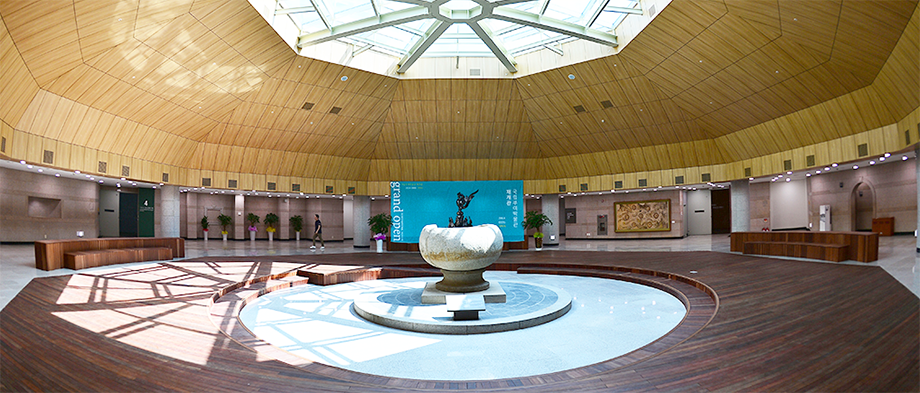 Stone Basin, BuyeoBuyeoseokjo(Stone lotus bowl of Buyeo)
Stone Basin, BuyeoBuyeoseokjo(Stone lotus bowl of Buyeo)
- ClassificationTreasure No. 194
- Original LocationPresumed site of a royal palace in Gwanbuk-ri, Buyeo
This stone basin, made by carving a large hole in a rectangular or spherical block of stone, was used to store water. It was discovered at a site where, according to some historians, the royal palace of Baekje was once located. The basin’s shape and the intricate carving techniques also suggest that it was used at a Baekje palace. The inscription on the surface of the basin describes the fall of Baekje to the forces of Tang China, and basically contains the same information as the inscription on the body of the first story of the Five-story Stone Pagoda at the Jeongnimsa Temple Site in Buyeo.
 Monument for Liu Renyuan of Tang China, BuyeoDangyuinwongigongbi(Monument to Liu jen-yuan)
Monument for Liu Renyuan of Tang China, BuyeoDangyuinwongigongbi(Monument to Liu jen-yuan)
- ClassificationTreasure No. 21
- Original LocationBusosan Mountain, Buyeo
Originally erected non the slope of Busosan Mountain, this stone monument is engraved with a eulogy praising the prowess of Liu Renyuan (dates of birth/death unknown), a general of Tang China who, as a leader of the Silla-Tang allied forces, played an important role in attacking and destroying Baekje in 660. The monument exhibits the characteristic style of Tang steles, consisting of a body inscribed with a commemorative passage, and a capstone carved with six dragons. It is thought that the monument originally stood on a tortoise-shaped pedestal, now lost. The monument's inscription contains some important historical facts related to the fall of Baekje and the subsequent revival movement’s struggle to restore it, and the disgrace of King Uija, Baekje’s last ruler, who was taken as a hostage to Tang along with the crown prince and about 700 government officials.
 What is a Stupa?
What is a Stupa?
A stupa is to a stone structure built to store sarira or the relics of a Buddhist priest. Stupas are often compared to the pagodas that were originally used to enshrine the relics of Sakyamuni Buddha. In Korea, the tradition of building stupas emerged after the introduction and spread of Zen Buddhism in the ninth century. Early stupas consisted of a foundation platform, a main body, and an ornamental finial, but these gradually developed into the octagonal pavilion style of stupa, which is marked by the octagonal shape of its main parts. After the Goryeo period (918-1392), Korean stone stupas began to feature more diverse shapes, including spheres, squares, and bells.
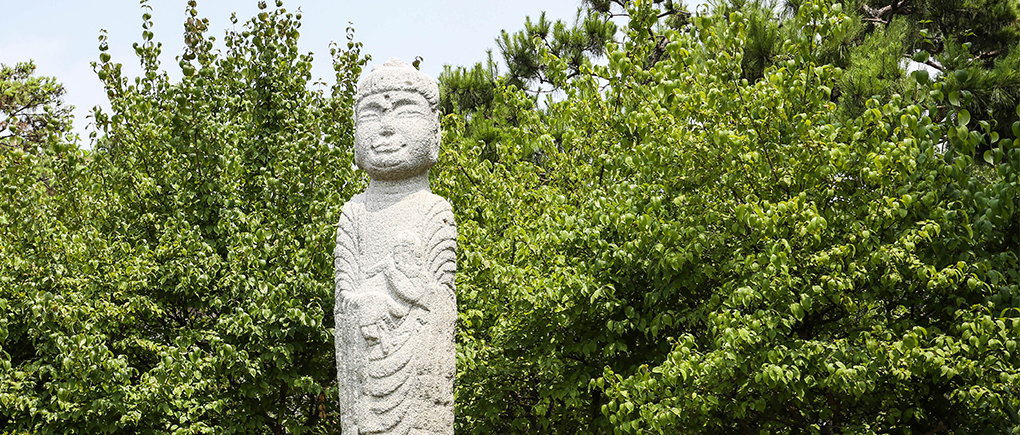 Stone Statue of Standing BuddhaBangmulgwanseokjoyeoraeipsang(Standing stone buddha statue)
Stone Statue of Standing BuddhaBangmulgwanseokjoyeoraeipsang(Standing stone buddha statue)
- ClassificationChungcheongnam-do Cultural Heritage Material No. 106
- Original LocationIn the vicinity of Cheonwangsa Temple Site in Dongnam-ri, Buyeo
This Stone Standing Buddha was discovered in 1933 in the vicinity of a site on Geumseongsan Mountain in Buyeo-eup, Buyeo-gun, where a Buddhist temple called Cheonwangsa once existed. The statue is characterized by a columnar shape, a disproportionately large head with a plump face, and a coarsely carved body exhibiting no distinctive qualities. Art historians believe that the statue was strongly influenced by the pillar-like Buddhist statues that were popular in the areas of present-day Chungcheong and Jeolla during the early Goryeo Period (918-1392), as exemplified by the Stone Standing Maitreya Bodhisattva of Gwanchoksa Temple in Nonsan, the Stone Standing Buddhas at the Anguksa Temple Site in Dangjin, and the Stone Standing Buddhas in Godo-ri, Iksan.
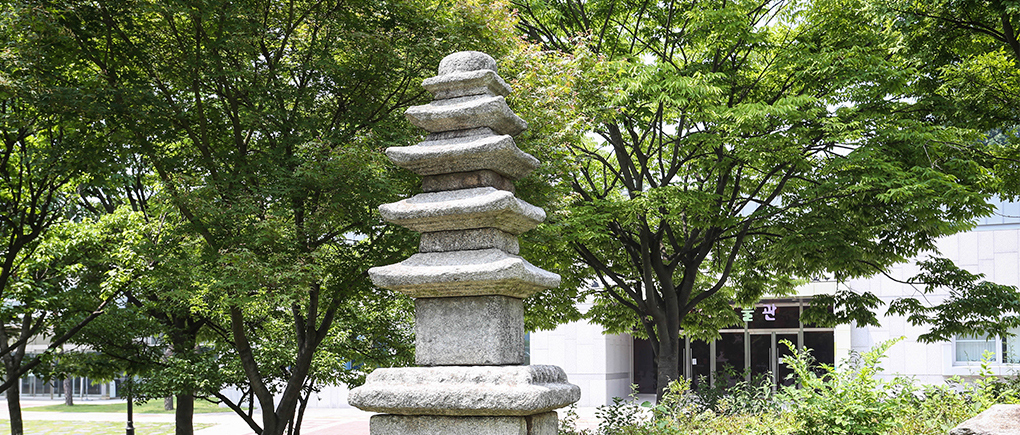 Five-story Stone PagodaDongnam-ri seoktap(Stone pagoda in Dongnam-ri)
Five-story Stone PagodaDongnam-ri seoktap(Stone pagoda in Dongnam-ri)
- ClassificationChungcheongnam-do Cultural Heritage Material No. 104
- Original LocationTemple Site in Seongmok-ri, Buyeo
This stone pagoda, which exhibits the techniques used to build a shrine to store the relics of Shakyamuni Buddha, originally stood at a temple site in Nonjeol Village in Seongmok-ri, Buyeo before it was moved to the museum. The pagoda consisted of a five-story body erected on a double-tier foundation platform, but the fourth-story and some parts of the platform have been lost. The entire structure exhibits the style of Unified Silla pagodas, which consisted of a multi-story body placed on a double-tier platform. However, the height of the body of each story is greater than its width, reflecting the typical style of early Goryeo pagodas.
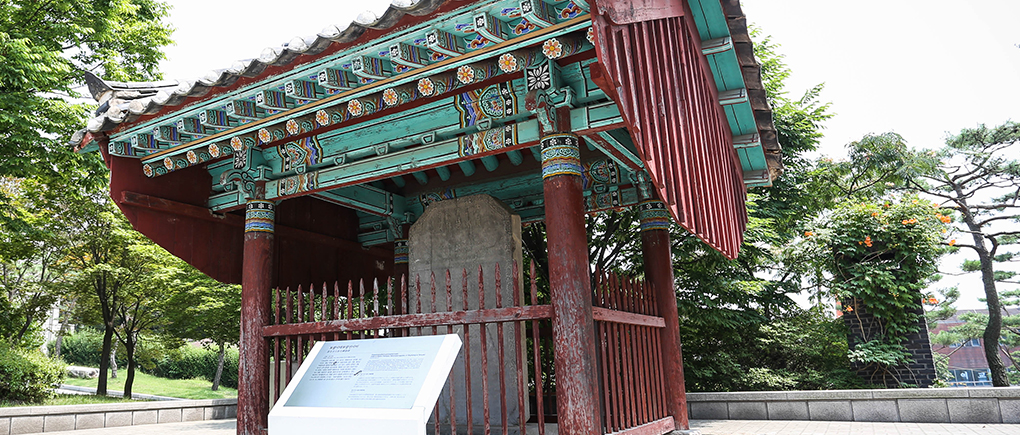 Stele for Great Master Bogwang from the Bogwangsa Temple SiteBogwangsadaebogwagseonsabi(Stele to Nation Preceptor Wonmyeong of Bogwang-sa Temple)
Stele for Great Master Bogwang from the Bogwangsa Temple SiteBogwangsadaebogwagseonsabi(Stele to Nation Preceptor Wonmyeong of Bogwang-sa Temple)
- ClassificationTreasure No. 107
- Original LocationBogwangsa Temple Site in Gasin-ri, Imcheon-myeon, Buyeo
This stone stele originally stood at the Bogwangsa Temple Site at Seongjusan Mountain in Imcheon-myeon, Buyeo-gun. It was erected to commemorate the life and achievements of State Preceptor Wonmyeong (pen- name: Chunggam, 1275-1339), who played a key role in reconstructing an ancient Buddhist temple called Bogwangsa. A Zen Buddhist monk ordained at Seonwonsa Temple, Preceptor Wonmyeong, crossed the sea to Yuan China to study Buddhism there. After returning home, he arrived at Bogwangsa Temple in 1336 and transformed it into a major Buddhist institution. The original epitaph and the title (written in seal script) inscribed on the stele are known to have been composed and handwritten by three renowned Yuan men of letters, Wei Su, Yang Chi, and Zhou Boqi. Because the original inscription was virtually effaced with the passage of time, a new inscription was written in 1750 by Neungil, then head monk of Bogwangsa Temple. The rectangular body with beveled top, supported by a pedestal, exhibits the typical style of late Goryeo steles.
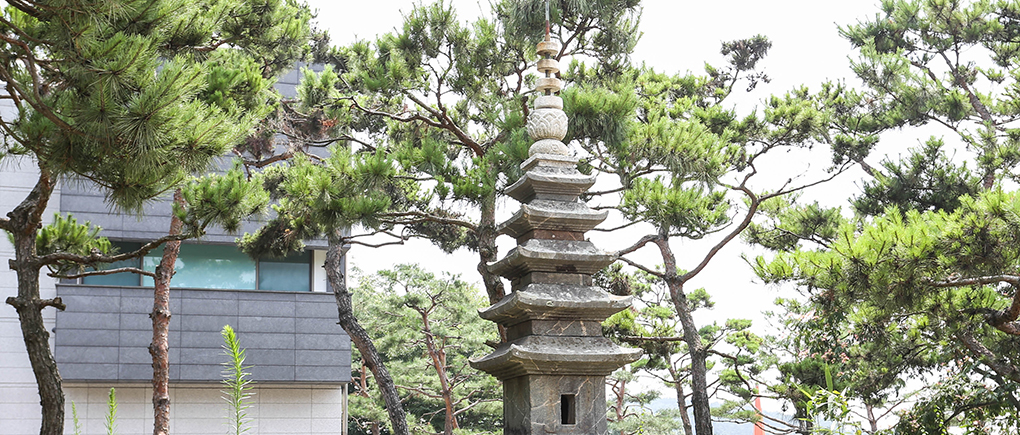 Stone Pagoda in Dongsa-riDongsariseotap(Stone pagoda in Dongsa-ri)
Stone Pagoda in Dongsa-riDongsariseotap(Stone pagoda in Dongsa-ri)
- ClassificationChungcheongnam-do Cultural Heritage Material No. 121
- Original LocationDongsa-ri Sedo-myeon Buyeo
This stone pagoda originally stood in Dongsa-ri, Sedo-myeon, Buyeo-gun, but it was moved to Ssangbuk-ri in Buyeo-eup in 1971, and then to the Buyeo National Museum in 1993. The pagoda consists of a double- tier platform, decorated with three "elephant eye" designs carved on each of the four sides of the lower platform, and a main body of five stories. The body support stone, which was placed on top of the cover stone of the upper platform, is decorated with a lotus design while its corners are adorned with protruding floral ornamentation. The pagoda’s first story is fairly large, and contains a niche with square holes designed to enshrine a Buddhist statue, while the upper stories are disproportionately small. Certain features, such as the body support stone decorated with lotus design, the drastically reduced size of the second to fifth stories, and the niche carved in the main body, suggest that the pagoda was made during the early Goryeo Period.
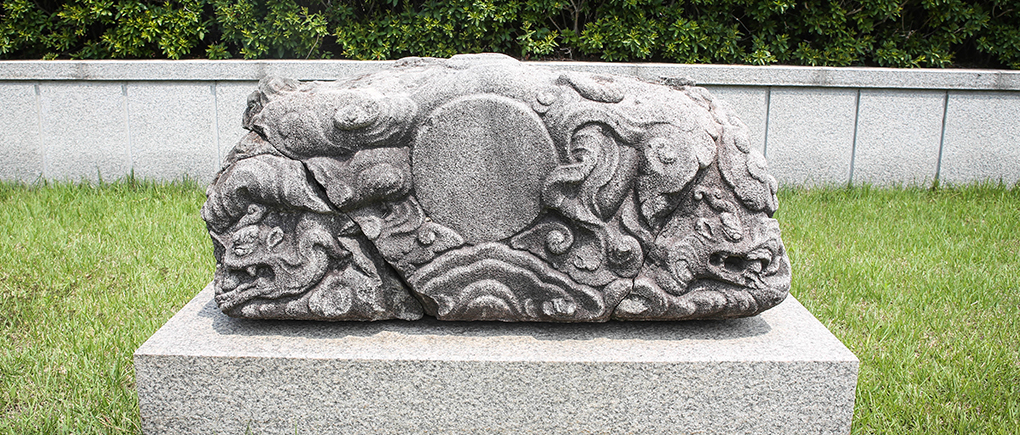 Dragon Capstone from the Seongjusa Temple SiteMonument Top Stone
Dragon Capstone from the Seongjusa Temple SiteMonument Top Stone
- Original LocationSeongjusa Temple Site in Seongju-ri, Seongju-myeon, Boryeong-si, Chungcheongnam-do
This ornamental stone engraved with dragon designs is one of the three main parts of a stone monument, the other two being the main body and the tortoise-shaped pedestal. This style of capstone was developed in Tang China and introduced to Korea after the unification of the three ancient Korean kingdoms by Silla. Unlike similar Chinese monuments, for which capstone and body were hewn from a single block of stone, Korean capstones were made using a separate block of stone. This capstone was discovered at the Seongjusa Temple site in Boryeong, which was the seat of the Nine Mountain Sects of Zen Buddhism. It is carved with intertwined dragons, and has a circular head containing the title of the stele. The Seongjusa Temple Site also contains a monument commemorating a renowned Zen monk named Muyeom, who died in 888. Judging from the different shapes of the two capstones, historians believe that this capstone was part of a stele commemorating a Zen monk who led the community of Seongjusa Temple during the Goryeo Period.
 Tortoise-shaped PedestalTortoise-Shaped Monument Stele Base
Tortoise-shaped PedestalTortoise-Shaped Monument Stele Base
- Original LocationSeongjusa Temple Site in Seongju-ri, Seongju-myeon, Boryeong-si, Chungcheongnam-do
This stone pedestal, made in the shape of a tortoise to support the body of a monument, shows signs of the influence of Tang China (618-907). While early pedestals, including that of the Stele of King Taejong Muyeol, had the shape of a tortoise’s head, those made after the mid-ninth century featured a dragon’s head. Now generally regarded as one of a pair along with the capstone discovered at the Seongjusa Temple Site in Boryeong, the body of the pedestal is slightly damaged in places, yet it still displays the realistic, dynamic representation of a tortoise achieved by the excellent carving techniques of Goryeo’s artisans.
